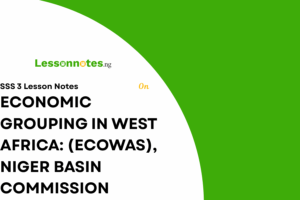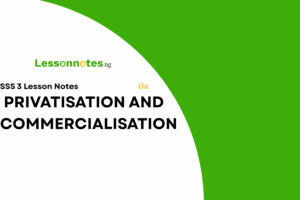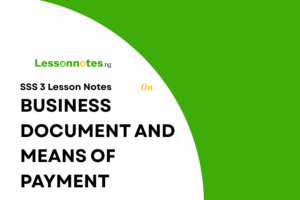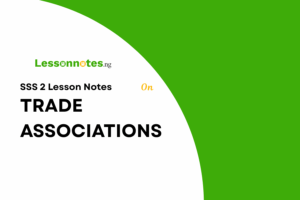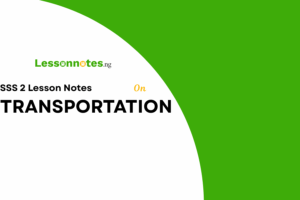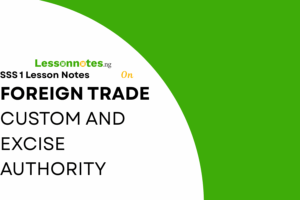Economic Grouping in West Africa (CONTD) West Africa Clearing House (WACH), Mano River Basin Commission. SS3 Commerce Lesson Note
Download Lesson NoteTopic: Economic Grouping in West Africa (CONTD) West Africa Clearing House (WACH), Mano River Basin Commission.
WEST AFRICAN CLEARING HOUSE (WACH) The West African Clearing House (WACH) was established in 1975 as a multilateral payment facility to improve sub-regional trade in West Africa. In 1996, the West African Clearing House was transformed into a broad-based autonomous agency called the West African Monetary Agency (WAMA). WAMA has more enlarged roles and functions.
The West African Monetary Agency (WAMA) is an autonomous specialised agency of the ECOWAS and is based in Freetown, Sierra Leone. History of the West African Monetary Agency In 1975, efforts to promote monetary integration in West Africa were realised when Central Banks in the sub-region signed the agreement to set up the West African Clearing House (WACH). The WATCH is a multilateral payment arrangement with the participation of all the Central Banks in West Africa, including BCEAO (La Banque Centrale De L’Afrique De L’Ouest).
The Commercial banks in the sixteen (16) West African countries also participated. In 1987, a remarkable step was taken towards the intra-ECOWAS Monetary Cooperation Program (EMCP). The EMCP involved the adoption of collective policy measures for achieving a harmonised monetary system and common management institutions. The transformation of WACH to WAMA was an integral part of the EMCP. The West African Monetary Agency was established in 1996 with the mandate to coordinate the affairs of the member countries towards the attainment of a single monetary zone for ECOWAS.
Membership of WAMA The West African Monetary Agency comprises seven Central Banks of the West African sub-region. These include BCEAO (for the nine (9) Francophone countries), Bank of Cape Verde, Central Bank of Gambia, Central Bank of Ghana, Central Bank of Liberia, Central Bank of Sierra Leone and Central Bank of Nigeria.
Objectives of the West African Monetary Agency (WAMA)
- Promotion and use of National currencies for regional trade and transactions;
- Bringing about savings in the use of foreign reserves for member states;
- Encouraging and promoting trade exchange liberalisation;
- Enhancing monetary cooperation and consultation among member states;
- Facilitating the harmonisation and coordination of monetary and fiscal policies.
Functions of the West African Monetary Agency (WAMA)
- To promote the use of local currencies for West African transactions to bring about savings in the use of foreign exchange;
- To promote trade liberalisation in member countries and for the countries to also consult frequently among themselves on monetary cooperation matters;
- Coordinating the implementation of the EMCP.
Challenges facing the West African Monetary Agency (WAMA)
- Inadequate funding;
- The problem of identity whereby some Pan-West African organisations that perform broadly similar functions already existed before and it is difficult for most outsiders to see where WAMA differs or is unique when compared to such other bodies e.g.: –
The ECOWAS-owned West African Monetary Institute (WAMI);
BCEAO and the West African Economic and Monetary Union of the Francophone West African States.
MANO RIVER UNION/BASIN COMMISSION
The Mano River Union (MRU) is an international association established between Liberia and Sierra Leone on 3rd October 1971 by Mano River Declaration; by the Malema Declaration, signed by President William Tolbert Junior of the Republic of Liberia and President Dr. Siaka Stevens of the Republic of Sierra Leone and enlarged by the accession of the Republic of Guinea and the Republic of Cote d’Ivoire, respectively on October 25th, 1980 and May 15th, 2008. It is named for the Mano River which begins in the Guinea highlands and forms a border between Liberia and Sierra Leone.
The Mano River is a river in West Africa. It originates in the Guinea Highlands in Liberia and forms part of the Liberia-Sierra Leone border. It is of great importance that people understand that the name Mano was not pulled out of a bag, but rather chosen because the River is the natural and formal boundary between the member states: Liberia and Sierra Leone. More importantly, it is in the area between present-day Liberia and Sierra Leone which was once one state or kingdom known as Kailahun Luwa.
Diamond mining is a major industry in these areas. Control of the area’s wealth and the instability of the national governments of all three countries led to a series of violent conflicts involving these districts in the 1990s.
Member states:
- Côte d’Ivoire,
- Guinea,
- Liberia, and
- Sierra Leone
Goal and Aims of Mano River Basin Commission
The goal of the Union was to “accelerate the economic growth, social progress and cultural advancement of our two countries … by active collaboration and mutual assistance in matters of common interest in economic, social, technical, scientific and administrative fields”. The Organization aims to strengthen the capacity of Member States to integrate their economies and coordinate development programs in the areas of peacebuilding, as a prerequisite to any development, trade promotion, development of industry, energy, agriculture, natural resources, transport and telecommunications, monetary and financial affairs in short, all aspects of the economic and social life of the Member States.
MRU MANDATE In May 2008, the Heads of State and Government of the Union decided to revive the Union. The MRU Secretariat was accordingly mandated by the May Summit to pursue the revival, growth, socio-economic development and integration of the sub-region within the framework of four pillars namely, institutional revitalization and restructuring with focus on the Union Secretariat and public sector of Member States; peace and security; economic development and regional integration; and social development. A strategic plan has been prepared to deal with all issues related to the pillars, a summary of which will be elaborated upon in the program section.
MRU WORK IN THE WEST AFRICAN SUB-REGION MRU maintains the initiation of dialogue at all levels between its Member States to achieve greater unity and solidarity, and promote goodwill, neighbouring cooperation and peaceful co-existence amongst its people, promoting peace, security, democratic principles and popular participation of citizens in the pursuit of good governance. Organisational structure The MRU is run by a secretariat, headed by a Secretary-General.
When Secretary-General Habib Diallo was killed in a car crash in 2011, his successor was the first woman to hold that office: Dr Saran Daraba Kaba. The Mano River Union Secretariat is based in Freetown, Sierra Leone, with offices in Conakry, Guinea and Monrovia, Liberia. In April 2016 the Union announced plans to form a Mano River Union Parliament, where legislators from the four member states will work to coordinate national legislation on matters of regional importance.
The Institutions of the Mano River Union and their Functions: In furtherance of the objectives of the Union, the following institutions were established: The Union Summit of Heads of State and Government which is the supreme institution of the Union; The Union Ministerial Council; The Union Technical Commissions; The Union Secretariat The Union Summit of Heads of State and Government: The Union Summit of Heads of State and Government is the supreme institution of the Union. The Summit shall convene as and when deemed necessary to deal with matters submitted to it by the Union Ministerial Council.
- The Union Ministerial Council: The Union Ministerial Council comprises Ministers responsible for Planning, Development, Economic Cooperation, Finance, Education, Trade, Industry, Agriculture, Transport, Communications, Energy, Natural Resources and Works in the Member States. Other Ministers of Member States may attend meetings of the Council when matters of interest to them are on the agenda. The decisions of the Union Ministerial Council shall be by consensus and such decisions shall be resolutions which: – Make recommendations to the Union Summit of Heads of State and Government; – Make recommendations to Member States for certain actions to be taken; – Give directives to the Secretariat and other subordinate Institutions.
- Technical Commissions of the Union: Technical Commissions were proposed to be established with responsibilities in the respective areas/sectors below: – Trade and Industry; – Agriculture, Forestry and fisheries; Transport and communications; – Education, Training and Research; – Finance and administration; – Energy and Natural Resources; – Peace and Security. The Commissions shall comprise Officials of Governments and Professionals designated by the Member States. They will examine issues relative to their respective fields on their initiative or upon the directive of the Union Ministerial Councilor at the request of the Secretary-General. The Commissions shall meet at least once a year but may hold special meetings as and when necessary based on the outcome of technical consultations or requests from Member States.
- The Mano River Union Secretariat: The Union Secretariat is the technical and administrative instrument through which the Union pursues its noble objectives. The Secretariat, in collaboration with the institutions of the Union and with support from donors and development partners, prepares strategic plans for the Union; oversees the formulation of projects and programs in support of the plan as well as their implementation, monitoring, evaluation and reports preparation; plans for and facilitate the holding of meetings of the institutions of the Union; approves projects and program in support of the objectives of the Union; represents the Union at various areas geared towards the political, social and economic development of the sub-region; and mobilises resources in support of projects and programs for the Union.


